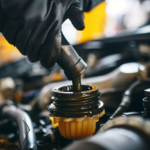Are you experiencing overheating issues with your vehicle? Learn how to perform a coolant system flush to keep your engine running smoothly. In this article, we’ll guide you through the process step by step. Gather your tools and materials, drain the old coolant, flush the system with clean water, refill with fresh coolant, and test for proper functioning. Don’t let a neglected coolant system leave you stranded on the side of the road – take action today!
Importance of Coolant System Maintenance
You need to understand the importance of coolant system maintenance. Maintaining your coolant system is crucial for the overall health and performance of your vehicle. The coolant system is responsible for regulating the temperature of your engine, preventing it from overheating. Over time, coolant can become contaminated with dirt, debris, and rust, which can lead to clogs and blockages in the system. This can cause the engine to overheat, leading to potential damage and costly repairs. Regular coolant system maintenance, such as flushing and replacing the coolant, helps to remove any contaminants and keep the system running smoothly. By taking the time to properly maintain your coolant system, you can ensure that your engine stays cool and performs at its best, prolonging the life of your vehicle.
Gathering the Necessary Tools and Materials
To perform a coolant system flush, you’ll need a few essential tools and materials. First, make sure you have a set of wrenches or pliers to remove the radiator cap and drain plug. These will allow you to access the coolant system easily. You’ll also need a drain pan to catch the old coolant as it is flushed out. This will help prevent any spills and keep your work area clean. Additionally, you’ll need a funnel to pour the new coolant into the system once the flush is complete. Lastly, make sure you have the recommended coolant and water mixture for your specific vehicle. Check your owner’s manual or consult a professional to ensure you have the right coolant for your car.
Draining the Old Coolant
To begin the coolant system flush, start by locating the drain plug and removing it using a wrench or pliers. The drain plug is usually located at the bottom of the radiator. Once you have located it, place a drain pan beneath the plug to catch the old coolant. Make sure the pan is large enough to hold all of the coolant. Once the drain pan is in place, slowly loosen the drain plug with the wrench or pliers, being careful not to let it fall into the pan. As the coolant begins to drain, you may need to adjust the position of the pan to catch all of it. Allow the coolant to drain completely before proceeding to the next step.
Flushing the System With Clean Water
Next, carefully and gradually flush the system with clean water to remove any remaining coolant residue. Flushing the system with clean water is an important step in the coolant system flush process. Start by filling the radiator with clean water, ensuring that it is at the appropriate level. Then, turn on the engine and let it run for a few minutes. This will circulate the water throughout the system, helping to remove any traces of old coolant. After running the engine, turn it off and allow it to cool down completely. Once cooled, drain the water from the radiator and repeat the process of filling it with clean water and running the engine again. Repeat this process until the water runs clear, indicating that all the coolant residue has been thoroughly flushed out.
Refilling the Coolant and Testing for Proper Functioning
Now, go ahead and refill the coolant system with fresh coolant while testing for proper functioning. Start by locating the coolant reservoir tank, usually located near the radiator. Remove the cap and pour the coolant into the tank until it reaches the recommended level marked on the side. Make sure to use the correct type of coolant specified by your vehicle’s manufacturer. Once the coolant is filled, start the engine and let it run for a few minutes. This will allow the coolant to circulate throughout the system. While the engine is running, check for any leaks or unusual sounds. Additionally, monitor the temperature gauge to ensure it stays within the normal range. If everything seems fine, turn off the engine and let it cool down. Finally, check the coolant level again and top it off if needed. Congratulations, you have successfully refilled the coolant system and tested for proper functioning.

Lucas is an experienced vehicle technician with hands-on knowledge of almost every car brand available. Throughout his career, Lucas has worked on a wide range of vehicles, including domestic and foreign models, sports cars, trucks, and SUVs.





